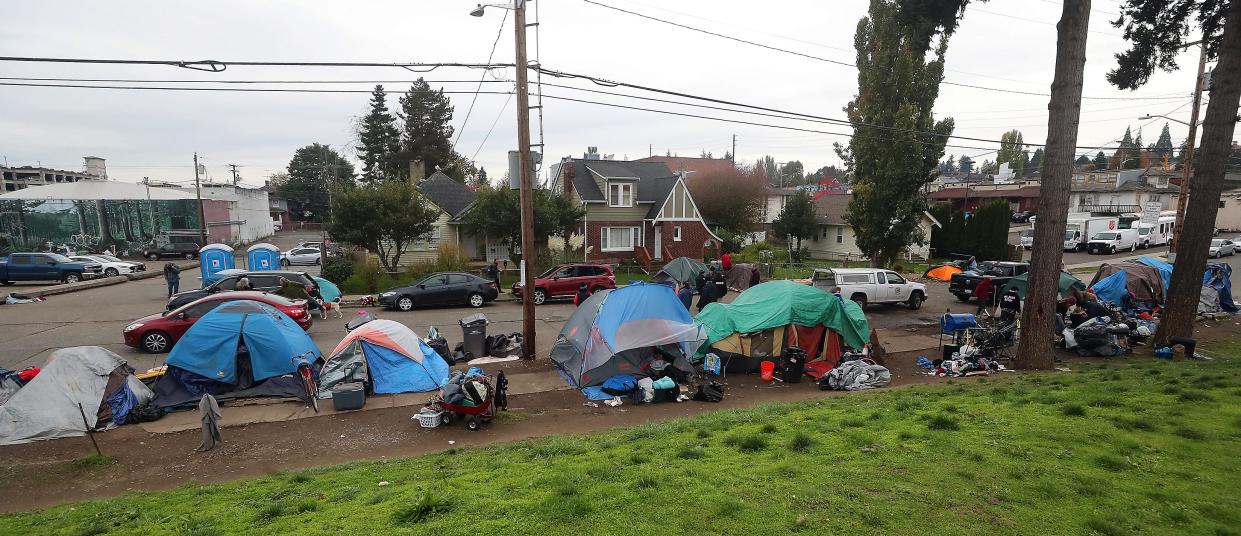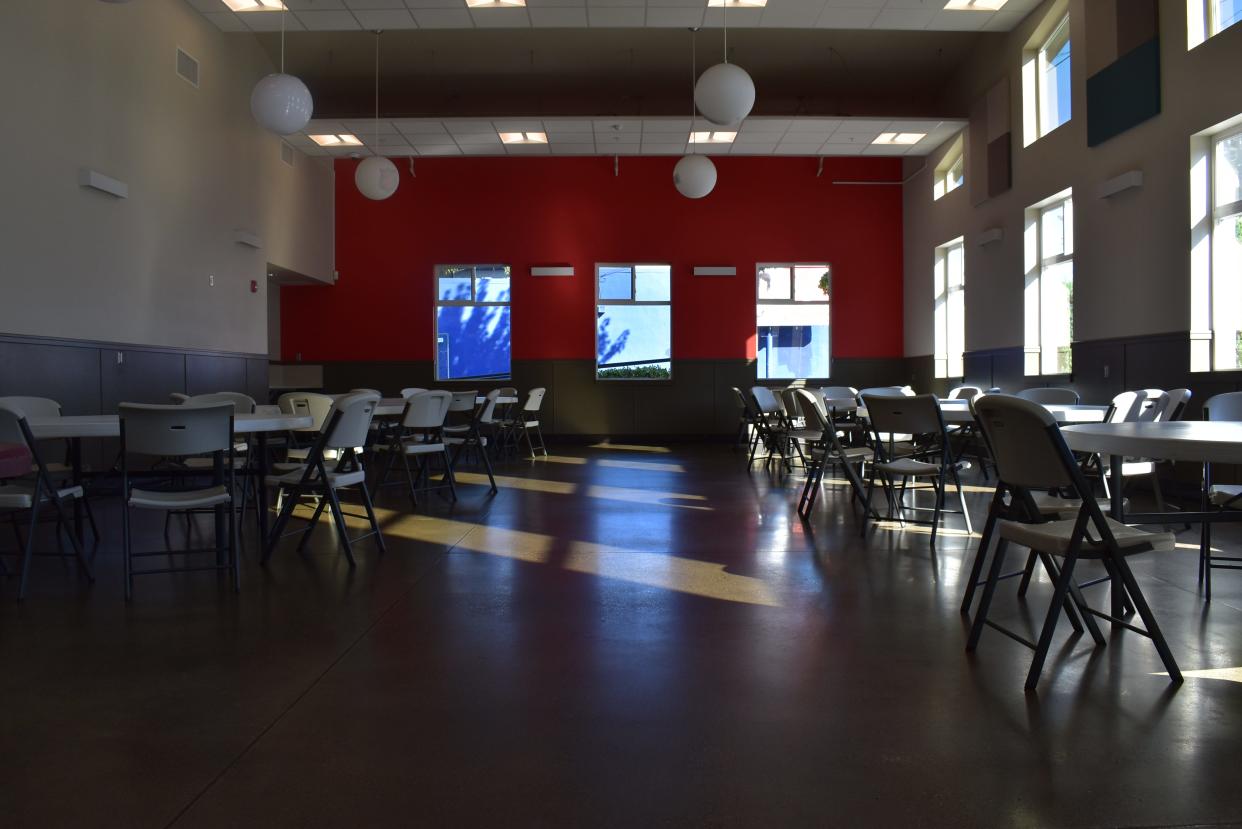Salvation Army’s shelter extends to May 2025, starting clock to find city's next shelter
May 1 once marked the date the Salvation Army in Bremerton would close its overnight winter shelter. This year, the date serves as a reminder of the one-year timeline homeless service providers in Bremerton currently have to create a long-term shelter for the city’s homeless population.
The Salvation Army, which a year ago closed its overnight winter shelter on April 30, a move that was followed by a growing encampment on the block just outside the facility's backdoors, has agreed to extend its overnight shelter function until May 1, 2025. That may help prevent another encampment from forming, and also would allow enforcement of a city ban on unauthorized camping, because emergency shelter would be available. But if a new shelter can’t be erected by next spring, homeless campers could face Bremerton’s unauthorized camping ban with nowhere to go.

Bridging the gap from one shelter to the next
Without the Salvation Army shelter, the city of Bremerton has had a problem managing its homeless crisis on the streets.
For about a decade, the Salvation Army has served Kitsap County with a temporary overnight shelter in its building on Sixth Street from December to March. When the COVID-19 pandemic struck, the city asked the nonprofit to extend its shelter and add a daytime component to it; a mission that carried on for three years until the Salvation Army closed its overnight shelter in the spring of 2023.
After a tent encampment grew behind the Salvation Army on MLK Way following the overnight shelter closure, the city was left with its hands tied, unable to enforce its unauthorized camping ban without available shelter beds due to a 2019 9th Circuit court case ruling referred to as Martin vs. Boise. When the Salvation Army reopened its shelter doors on November 1, making the ban enforceable again, Mayor Greg Wheeler vowed to never let the city go without shelter space again.
Wheeler’s administration proposed a low-barrier congregate shelter on Oyster Bay Avenue with a capacity of up to 100 people, but the City Council decided to go another direction, voting in January to pursue a hybrid shelter solution proposed by the Kitsap County Affordable Housing Taskforce for both a congregate 50-bed shelter and a 40 unit pallet shelter village.
Wheeler’s shelter was planned for completion in October 2024, which would have left the city to face another summer without available shelter space and the subsequent possibility of another large encampment building up.
He looked to the Salvation Army to bridge the gap.
Salvation Army’s original May 1 closure date lit a fire under the vote for a shelter option, as Wheeler told the council that asking the nonprofit to extend its service was an impossibility. But given the gap, the Salvation Army agreed to extend its overnight shelter function until Wheeler’s shelter would have opened in October, then eventually agreed to provide that extension through the winter until May 1, 2025.
Though the Salvation Army is a nonprofit, the extension still comes at a cost.
The price of shelter
The Salvation Army has verbally committed to an extension for another year, but is currently working on a contract that reaches into September, paid for by Kitsap County with American Rescue Plan Act (ARPA) funds, Wheeler said.
To operate the shelter from its opening on November 1 to the end of the contract, extending through September, it will cost about $1.5 million, said Kitsap County Housing and Homelessness Program Manager Carl Borg. To take the shelter through May 2025, it will cost close to another $1 million.
To stay open another year, things won’t have to change much for the Salvation Army, as it is already accustomed to years-long shelter operation. The agency will retain its same 23 shelter staff members who are already doing the work, said Captain Dana Walters of the Salvation Army. She emphasized that the shelter could always use more volunteers.
The cost to run the shelter will cover worker wages, utilities, laundry, showers, hygiene and a meal program that has been feeding those in need with about 250 to 300 meals per day, Walters said. On an average night currently, the Salvation Army shelters about 60 to 72 people, but Walters doesn’t expect that number to change much in the summer, anticipating 50 to 60 people per night.
Approximately $477,000 of the October to May funds have been covered by state legislative appropriation, Borg said, leaving the remaining funding up to a search for grants.
“We'll have to get started right away at figuring out where the next money is going to come from to keep us going,” Wheeler said. Over the summer, he will work with the county to find state grant opportunities.

For now, ‘We’re just making it work’
The Salvation Army’s building is not a shelter, Walters said – a common misconception.
Every day the shelter function is open, workers inside break down the dining room, clearing tables and chairs and sanitizing surfaces to lay out 72 sleeping mats and other nighttime aids, to pack it all up and reset the day center the next day. Simply put, there isn’t enough room for all of the Salvation Army’s functions – three square meals, case management, chapel and more – to use space simultaneously.
“We're just making it work, essentially,” Walters said. “It's hard to run a daily thing going on when there's mats all the way down the hall.”
When the staff is converting the space, guests at the Salvation Army have to momentarily clear out. A handful of its homeless guests hang around the building on MLK Way where others used to camp, to spend time outside away from others or waiting for the free meals.
“It'd be great to have a shelter (built) instead of having to make a shelter every day,” Walters said.
Though the Salvation Army had been the city’s lifeline, Wheeler doesn’t believe reliance on the nonprofit can be a long-term solution.
“We can't expect to put this all on their shoulders and have that be our community safety net,” Wheeler said. “Our community needs to step up.”
Countdown to May 2025
If Wheeler’s congregate shelter concept had been approved by the City Council back in January, he believes the project would currently be prepping the ground at Oyster Bay Avenue and ordering the sprung structure for installation in May or June, confidently on the way toward an opening in October.
Wheeler’s shelter was abandoned after community and city council concerns rose about providing transitional housing options rather than just bare minimum shelter with no solid plan for wraparound services that treat homelessness. Wheeler believes that decision left behind the clearest and most straightforward path toward some type of shelter.
“I expect (the Kitsap County Affordable Housing Taskforce) to be working with the same urgency,” he said. “We do need a low-barrier walk-up shelter.”
And because Wheeler’s priority has been not only providing shelter for those in need, but to maintain the city’s ability to enforce its unauthorized camping ban to avoid growing encampments, a United States Supreme Court case hailing from Grants Pass, Oregon, is coming to the fore.
A majority of the Supreme Court justices will decide whether or not to uphold Grants Pass’ city ordinances that actively outlawed camping in public spaces while walk-up shelter space was unavailable. The justices heard oral arguments on April 22 and appear inclined to side with the City, reported the New York Times.
The Supreme Court is predicted to make its decision in late June or early July and if it follows through with its lean toward upholding the city ordinances, the protections awarded to homeless campers in Martin v. Boise would be effectively overturned, allowing cities like Bremerton to enforce their unauthorized camping ordinances even if available shelter space isn’t available.
“I don't want to be in a position to enforce this law if we don't have a shelter option for people and if we're allowed to enforce it without a shelter option,” Wheeler said. “But that being said, we will. We'll enforce it.”
The long road towards a long-term solution
Bremerton Housing Authority Executive Director Jill Stanton knows the goal the Affordable Housing Taskforce is up against with the closure of the Salvation Army shelter in May 2025, but she doesn’t yet have a shareable timeline to deliver the hybrid shelter.
“Can we do something that might be impossible? We're sure going to try,” she said.
The Affordable Housing Taskforce hasn’t secured a contract for a shelter site yet and therefore hasn’t been able to conduct outreach with a surrounding community, Stanton said. The taskforce has also come up against a city code that they’re working with the city to amend, which only allows for a pallet shelter-type encampment for up to about six months.
The Swing Set Mall, a site in East Bremerton previously eyed by the taskforce and city council members for a hybrid shelter location in January appears to be off the table as well. Building and business owner Andrew St. Hilaire said, “Unfortunately, we were not able to make a deal with the Bremerton Housing Authority that made sense for our business having to relocate,” though he is open to considering a sale if anything changes.
Recent: Option for shelter and pallet homes passed by Bremerton's council, nixing Oyster Bay plan
The Affordable Housing Taskforce’s hybrid shelter has received dedicated funding from the county and the city and received several design structures. The team is currently considering operational, security and building plans while developing protections for a community that could be nearby the next shelter site.
The task force's plan to free up shelter space and move people on to independent living has already made significant headway, Stanton said. Using agreements with specialized shelters to make referrals into the BHA’s voucher program, the BHA has already seen over 100 referrals since March. Though not all applicants are guaranteed to be successful, especially in a constrained housing market, the progress is emblematic of the task force’s mission to move homeless people up the continuum of housing.
When the Affordable Housing Taskforce eventually establishes its hybrid shelter, Walters said the Salvation Army would be open to continuing providing its shelter services by submitting a request for proposal to operate the shelter or would consider operating their shelter in supplementation of the hybrid shelter if the city needed it.
“I'm looking forward to people being able to have something that's permanent,” Walters said.
This article originally appeared on Kitsap Sun: Bremerton's Salvation Army extends homeless shelter until May 2025
